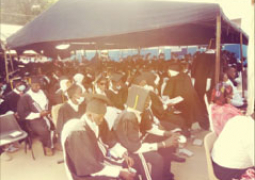
The team was headed by Sheikh Tijan Sosseh, ex-coordinator of African Emergency Locust Project (AELP), Gambia Emergency Agricultural Productivity Programme (GEAPP) and West African Agricultural Production Project (WAAPP).
The site visit comes on the heels of an alert from the FAO of a looming locust outbreak in East Africa and there is probability that it may invade this part of Africa at any time.
It was in this move that the Ministry of Agriculture acted swiftly and set up an emergency desert locust preparedness taskforce and national resource mobilisation committee. These structures were built during Sosseh’s tenure as project coordinator of these phased-out agric projects, where he carved a niche for himself in the country in respect of project implementation.
Meanwhile, these locust structures visited were built by the phased out -African Emergency Locust Project (AELP) under the supervision of Sheikh Tijan Sosseh.
The team was tasked by the Ministry of Agriculture to ensure that all centres are visited and to come up with suggestions, recommendations to find a solution before any unexpected locust invasion in the country.
During the site visits, what the visiting team found on the grounds was appalling, thus highlighting the need for urgent attention to ensure that the equipment are properly maintained in a high standard ‘if the country is to make any headway in case of any locust invasion.’
“The team also recommended that the existing structures are put in accordance as most of the structures are scrap and need urgent maintenance.”
After the assessment, a report was submitted to the Ministry of Agriculture with all the recommendations on the need for proper maintenance.
“The team was also able to mobilise well-experienced and expert engineers to ensure that most of the equipment were tested and repaired.”
The team also recommended for the training of military personnel, civil society, extension workers and the media to ensure that The Gambia is well equipped to withstand any emergency.




